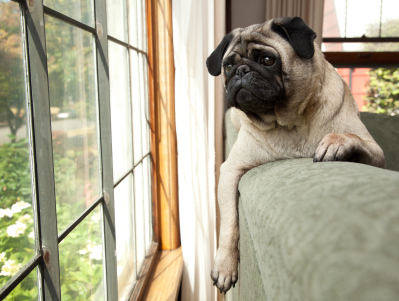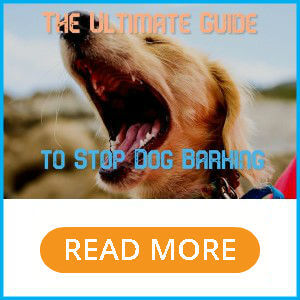
Separation anxiety is a challenging condition that many dog owners try to avoid or have difficulty facing.
The truth is, all dogs can easily develop separation anxiety if they’re not getting the attention and affection they need. But, even if you do this, there could be a chance of your dog developing it anyways!
Some breeds and personalities are commonly given the name of velcro dogs, making it easier for them to develop separation anxiety. Such breeds that can get this are the Labrador Retriever, Border Collie, Jack Russell Terrier, German Shepherd, Australian Shepherd, Bichon Frise, Australian Shepherd, Toy Poodle, Pug, Frenchie and more.
Suppose you also have adopted a dog from another home or rescue centre. In that case, it’s most likely after your dog was rehomed they will be at greater risk of developing separation anxiety than dogs born into a more stable environment.
When these rehomed dogs finally find their “forever home,” they may become overly attached to their rescuer. But when their rescuer leaves the dog alone, even for a short period, the dog may relive their earlier trauma in the form of separation anxiety – the often overwhelming fear that they have once again been left to fend for themselves.
Why do dogs develop separation anxiety?
The main reason dogs develop separation anxiety is that it all stems back to their wolf ancestors. Dogs are pack animals and feel most comfortable when they are with their pack, whether their pack is composed of fellow dogs, humans, or both.
Several triggers your dog could develop this type of anxiety, such as moving house, a change in routine, a death in the family, separation from their brother, sister, mother and many other factors.
Being alone is not natural for them, and thus, feeling abandoned by their pack can be very traumatizing. Dogs can also develop different types of anxiety too such as:
Fear anxiety
If your dog is left alone for long periods in a noisy environment, it could stress them out. In particular, any loud bangs like fireworks, loud music, strange atmospheres, and much more could trigger this. Fear anxiety can be made worse when you’re not around to help your dog adjust to such environments.
Age-related anxiety
As your dog gets older, it could also develop age related anxiety. This normally happens when they have cognitive decline and their brain is not functioning correctly. In these scenarios, separation anxiety and age-related anxiety combined could make your dog even more unwell. So it’s always best to be around your dog to comfort them.
Finally, the difficulty with separation anxiety is that not every dog displays separation anxiety the same; there’s are different signs and symptoms that they might show. As a dog owner, you must recognise them before they manifest into something worse, as they could cause your dog serious distress.
What are the signs of separation anxiety in dogs?
To help save your dog’s separation anxiety manifesting into something much worse, here are common signs and symptoms to look out for:
- Destructive behaviour such as clawing and digging at door frames, window frames, carpets and flooring, etc.; chewing on objects around the house, like stuffed animals or shoes or even biting or scratching themselves; urinating or defecating in the house, even if they’ve been properly housetrained. This destructive behaviour is exhibited whenever left alone, even for a short time. It can be so severe that significant damage is done to themselves and your home.
- Your dog follows you around the house and does not let you out of their sight, especially if they sense you might be getting ready to go somewhere. They whine, bark, or otherwise vocalize before you leave, when you leave, and/or while you are gone. You may get complaints of excessive barking from your neighbours.
- When returning home, your dog is almost frantic and overly emotional.
How do you cure separation anxiety in dogs?
If you’re looking to dog separation anxiety treatment, there are a few solutions which are:
Exposure therapy
One of the most common ways to reverse separation anxiety, especially in mild to moderate cases, is sometimes referred to as exposure therapy. This just means that you slowly increase the duration of time you are away from your dog until they are calm and comfortable with both your departures and returns. Exposure therapy will not work unless you also follow the next three points:
This can help to reduce your dog’s energy and anxiety levels greatly. Consider hiring a local dog-walking company to walk and exercise your dog, especially if you cannot take your dog for long walks during workdays. Most dogs do not get enough exercise or socialization with other dogs, which can significantly exacerbate canine separation anxiety.
- Keep calm at all times
Remain calm when you leave the house and when you return. Do not respond to your dog’s emotional and/or frantic behaviours. When you respond, you are reinforcing the behaviour.
- Be patient with your pooch
Remain patient with your dog at all times, and make sure your home environment is calm, non-threatening, and stable. NEVER hit, yell at, or otherwise punish your dog. Dogs are far more responsive in steady, consistent settings.
For very severe cases of separation anxiety, when your dog has become a threat to themselves, some vets recommend the use of anti-anxiety medications. If you choose this option, it should be used as a last resort.
- Give your dog toys
To help your dog, you might wish to give them toys or treats just before you leave the house each time. This will get them excited and distracted to play with new things and keep their mind busy while you’re gone.
- Speak to your veterinarian
If you feel your dog’s separation anxiety is getting out of control, you may wish to speak to your local vet. If you do, your vet might recommend an over the counter calming agent or specific medication to help keep your dog relaxed and destressed while you’re gone.
What won’t help separation anxiety
While we’ve covered what will help, it’s essential to know what you should not do in these moments that could make your dog’s separation anxiety worse. You should avoid doing the following:
- Punishment: This will only make your dog’s separation anxiety worse.
- Buying a new dog: The reason for your dog’s separation anxiety is because they’ve developed anxiety being away from you, not another dog.
- Crating: Your dog will still show separation anxiety symptoms and could defecate, howl and injure themselves in a crate. You must create a safe space.
- Loud noises: Noises from the radio, Tv, or anything else will only make your dog more distressed.
Final thoughts
Separation anxiety is a condition many dog owners face and sometimes one that is hard to avoid. After all, there are more breeds prone to it than others. The reason dogs face it is because they are pack animals and treat their owner as one of their pack members. Typical signs of separation anxiety are self-destructive behaviours, barking, whining, crying, chewing, scratching and much more.
If your dog displays separation anxiety symptoms, you can give them toys to play with, let them undergo exposure therapy and speak to your veterinarian if it gets out of hand. Overall, as a dog owner, it’s your duty that your dog is not left for too long on its own, and they get the affection they deserve.
FAQS
Will dogs stop eating if they are stressed?
Most of the time, if your dog is suffering from chronic stress, they could have a reduced appetite and have problems with their digestion. If your dog does this, review any recent changes made to their routine and surroundings first and try to help them adjust. If your dog still does not eat, seek the help of a veterinarian.
How can I help my dog with car anxiety?
If you notice your dog getting stressed while on the road, you should consult your veterinarian about motion sickness and anxiety. It’s most likely your dog will be prescribed anti anxiety medication to help them with car journeys. You might also want to exercise them a lot before the journey and tire them out before seeing a vet.
Does Benadryl help dogs with anxiety?
Dogs can be given Benadryl to treat anxiety. One of the main side effects of this medication is that it makes dogs tired, and it helps calm their anxiety. If you want to give your dog this, you should always speak to your veterinarian first.




